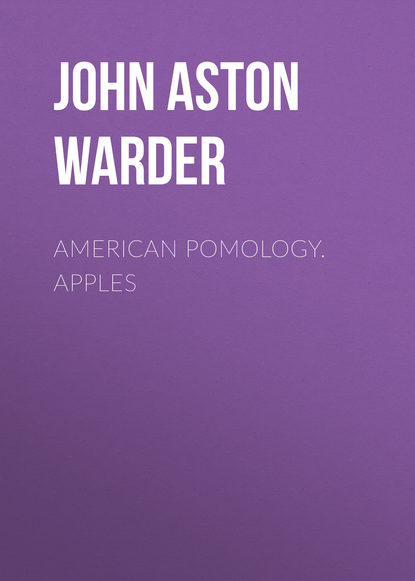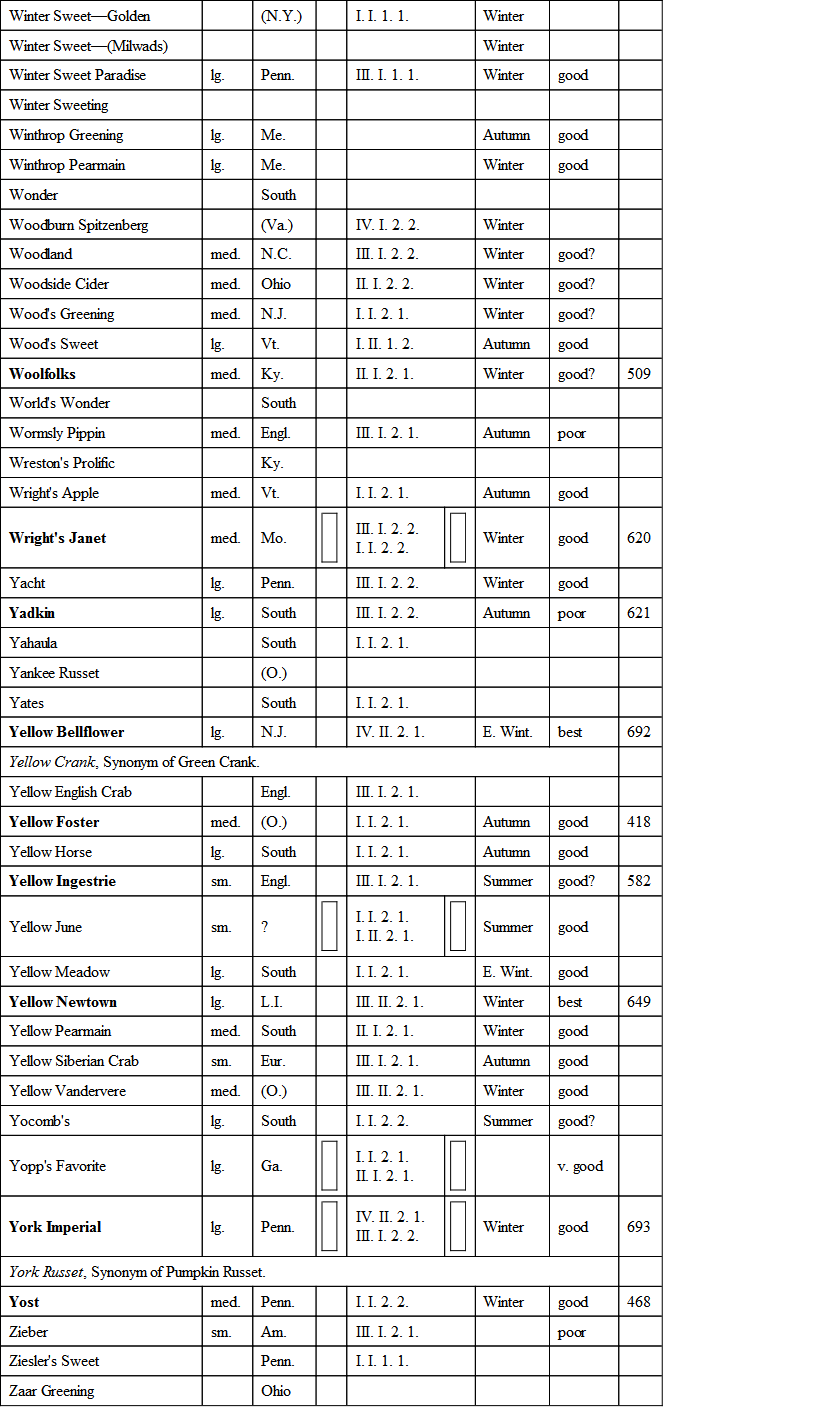 Полная версия
Полная версияAmerican Pomology. Apples
AUTUMN.
* Haskell Sweet,
* Kinsey's Sweet,
Lyman's Pumpkin,
Ramsdell's,
Spice Sweet,
* Superb Sweet.
* My friends write that they would have preferred more of these sorts, and that they planted such trees as were at hand at that time.
WINTER.
Baldwin Sweet,
Broadwell,
Butter Sweet,
*Danvers' Winter,
Honey Sweeting,
*Ladies' Sweeting,
Late Pound Sweet,
May,
McKay's Favorite,
*Phillips' Sweeting,
*Tallman's Sweeting,
Wells' Sweeting,
Winter Sweeting.
* My friends write that they would have preferred more of these sorts, and that they planted such trees as were at hand at that time.
ALSO, LESS KNOWN,
Acid Sweet,
Akeson's Sweet,
Beauty of the West,
Cash Sweet,
Charlotte Sweet,
Climb Sweet,
Ling Sweet,
London Sweet,
Merritt's Sweet,
Mt. Pleasant Sweet,v Morgan's Favorite,
Red Sweet Pippin,
Stone Sweet.
Planted by A.L. Benedict, Morrow County, Ohio, in a lot to be devoted to hogs. The numbers of each might be varied:
2 Bough,
3 Golden Sweet,*
6 Jersey Sweet,*
16 May of Myers,
10 Moore's Sweeting,
32 Pumpkin Sweet,
8 Raritan Sweet,
17 Spice Sweet,
1 Tift's Sweet,
19 Tallman Sweet,
30 Whitmore Sweet,
14 Wing Sweet.
* My friends write that they would have preferred more of these sorts, and that they planted such trees as were at hand at that time.
L. Hampton's list52 for a succession through the year:
Bentley Sweet,
Bough,
Broadwell,
Fall Sweet,
Federal Sweet,
Golden Sweet,
Hightop Sweet,
Honey Greening,
Kentucky Sweet,
Paradise Winter,
Scarlet Sweet,
Simpson's,
Smith's Sweet,
Sweet Favorite,
Winter Sweet.
For Illinois, by W. Cutter, in Prairie Farmer:
Broadwell,
Golden Sweet,
Paradise Winter,
Ramsdell Sweet,
Sweet June,
Sweet Nonesuch.
Sweet apples arranged in succession for stock. Those marked T. are also fine for the dessert; those marked B. are superior for baking:
Hightop, B.
Bough, T.
Golden Sweeting, B.
Victuals and Drink, B. T.
Jersey Sweet,
Lyman's Pumpkin, B.
Bailey Sweet, B. T.
Ramsdell's, B.
Mote's Sweet, B. T.
Stillwater Sweeting, B.
Higby Sweet, B.
Dr. Watson, T.
Molasses,
Fall Queen, B. T.
Buckingham,
Baltimore,
Fallawater,
Michael Henry,
Broadwell, T. B.
Sweet Bellflower,
Sweet Janet, B.
London Sweet, B.
Winter Sweet Paradise, T. B.
Jersey Black,
Ladies' Sweeting, T. B.
Tallman's, B.
Holton's,
Moore's Sweeting,
Gilpin,
Campfield,
Sweet Vandervere,
Red Winter Pearmain,
Swaar,
Black Gilliflower.
In giving selections of Cider Apples I will begin with the veteran Coxe's list:
American Pippin,
Campfield,
Cooper's Russeting,
Gloucester White,
Golden Reinette,
Hagloe Crab,
Harrison,
Hewes' Crab,
House, or Gray-House,
Red Streak,
Roane's White Crab,
Ruckman's Pearmain,
Styre,
Winesap.
A select list of Cider Apples that may be found in many collections, all good bearers:
Campfield,
Gilpin,
Harrison,
Hewes' Crab,
Newtown Pippin,
Priestley,
Rawle's Janet,
Waugh's Crab,
Winesap.
CATALOGUE AND INDEX OF APPLES
EXPLANATION
The first column presents the name of the apple, next its size, then its origin; or, if in brackets, the place where the variety is cultivated and was found. The Roman numerals indicate the Class and Order to which it is referred, and the Arabics, the Section and Sub-section, according to the classification adopted in this work. After this comes the season of maturity, Summer, Autumn, Winter, Spring, and the estimate of quality, from very best, best, very good, good; good? meaning almost good; poor? meaning rather so, and last plainly poor, when considered decidedly inferior. The names of varieties described in this volume are given in full faced type, with reference to the pages, while synonyms are printed in Italics. Abbreviations will explain themselves.






1
Companion for the Orchard.—Phillips.
2
Elliott—Western Fruits.
3
North American Sylva, Nuttall II, p. 25.
4
Diary.
5
History of Knaresborough, p. 216.—Companion of the Orchard, p. 34.
6
Our lexicographers give it a similar origin, but refer it to the shape in which it was put up. Others derive it from poma, Spanish, a box of perfume.
7
Phillips' Companion, p. 32.
8
Phillips' Companion, p. 41.
9
Balfour's Manual.
10
Balfour's Manual.
11
Balfour's Manual, p. 284.
12
The Plant, a Biography: M.J. Schleiden, p. 68.
13
Because it had no root, it withered away. Mat. 13, 6.
14
A.R. Whitney, Franklin Grove Nurseries, Lee Co., Ill.
15
Trans. Horticultural Society, London, Vol. II, p. 308; and Am. Journal of Science and Arts, March, 1840.
16
Trans. Cincinnati Horticultural Society, 1865.
17
Cincinnati Hort. Soc. Report.
18
See Lawrence Young's Experiments, in Western Horticultural Review, Vol. I. page 190, in Report of Kentucky State Fruit Committee to American Pomological Congress, for 1850.
19
Western Horticultural Review; also, Statistics of Storm, Jan. 1, 1864.
20
Bursting open of the pods, or of the hulls of nuts.
21
Balfour's Manual.
22
Practical Entomologist, 518 South 13th street, Philadelphia, fifty cents a year, in advance.
23
Vide Prairie Farmer, American Agriculturist, Country Gentleman, etc.
24
See Practical Entomologist, Vol. II, p. 32.
25
See Practical Entomologist, Vol. II, p. 31.
26
Harris, p. 205.
27
Harris' Report, p. 310.
28
For further details of these insects, the reader is referred to Fitch's Report, pp. 82 to 98.
29
Rept. cit., p. 100.
30
Rept. cit., p. 122.
31
Rept. cit., p. 125.
32
Rept. cit., p. 134.
33
Trans. N.Y. Ag'l Soc., 1856, p. 359.
34
Lib. cit. p. 435.
35
Harris' Rept. p. 211.
36
For further particulars respecting these insects, consult Dr. Fitch's Rept., p. 5, and Harris's Rept., p. 241.
37
Vide Harris' Rept., p. 232.
38
Rept., p. 403.
39
Rept., p. 241.
40
Vide Fitch, in N.Y. Trans. 1856, p. 382.
41
For interesting details vide Fitch's Rept., p. 221.
42
Rept., p. 256.
43
See Fitch's Report, p. 176.
44
See Fitch's Report, p. 252.
45
From καρπος, Greek, for fruit.
46
As translated for R. Hogg's British Pomology.
47
Figures 36 to 46, pp. 355 to 356.
48
Vide Horticulturist for 1861 p. 40.
49
Fall Butter, on page 677, belongs here.
50
See page 670.
51
See Reports of American Pomological Society.
52
Ohio Cultivator, vol. VI, page 269.



